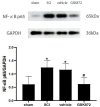Receptor-Interacting Protein Kinase 3 Inhibition Relieves Mechanical Allodynia and Suppresses NLRP3 Inflammasome and NF-κB in a Rat Model of Spinal Cord Injury
- PMID: 35514432
- PMCID: PMC9063406
- DOI: 10.3389/fnmol.2022.861312
Receptor-Interacting Protein Kinase 3 Inhibition Relieves Mechanical Allodynia and Suppresses NLRP3 Inflammasome and NF-κB in a Rat Model of Spinal Cord Injury
Abstract
Background: Neuroinflammation is critical in developing and maintaining neuropathic pain after spinal cord injury (SCI). The receptor-interacting protein kinase 3 (RIPK3) has been shown to promote inflammatory response by exerting its non-necroptotic functions. In this study, we explored the involvement of RIPK3 in neuropathic pain after SCI.
Methods: Thoracic (T10) SCI rat model was conducted, and the mechanical threshold in rats was measured. The expressions of RIPK3, nod-like receptor family pyrin domain-containing protein 3 (NLRP3), caspase-1, and nuclear factor-κB (NF-κB) were measured with western blotting analysis or quantitative real-time polymerase chain reaction (qRT-PCR). Double immunofluorescence staining was used to explore the colabeled NLRP3 with NeuN, glial fibrillary acidic protein (GFAP), and ionized calcium-binding adapter molecule 1 (IBA1). In addition, enzyme-linked immunosorbent assay (ELISA) was applied to analyze the levels of proinflammatory factors interleukin 1 beta (IL-1β), interleukin 18 (IL-18), and tumor necrosis factor alpha (TNF-α).
Results: The expression of RIPK3 was elevated from postoperative days 7-21, which was consistent with the development of mechanical allodynia. Intrathecal administration of RIPK3 inhibitor GSK872 could alleviate the mechanical allodynia in SCI rats and reduce the expression levels of RIPK3. The activation of NLRP3 inflammasome and NF-κB was attenuated by GSK872 treatment. Furthermore, immunofluorescence suggested that NLRP3 had colocalization with glial cells and neurons in the L4-L6 spinal dorsal horns. In addition, GSK872 treatment reduced the production of inflammatory cytokines.
Conclusion: Our findings indicated that RIPK3 was an important facilitated factor for SCI-induced mechanical allodynia. RIPK3 inhibition might relieve mechanical allodynia by inhibiting NLRP3 inflammasome, NF-κB, and the associated inflammation.
Keywords: GSK872; NLRP3 inflammasome; neuropathic pain after spinal cord injury; nuclear factor-kappa B (NF-κB); receptor-interacting protein kinase 3.
Copyright © 2022 Xue, Cao, Wang, Zhao, Han, Yang and Sun.
Conflict of interest statement
The authors declare that the research was conducted in the absence of any commercial or financial relationships that could be construed as a potential conflict of interest.
Figures






Similar articles
-
Resveratrol suppresses neuroinflammation to alleviate mechanical allodynia by inhibiting Janus kinase 2/signal transducer and activator of transcription 3 signaling pathway in a rat model of spinal cord injury.Front Mol Neurosci. 2023 Feb 16;16:1116679. doi: 10.3389/fnmol.2023.1116679. eCollection 2023. Front Mol Neurosci. 2023. PMID: 36873101 Free PMC article.
-
Extracellular vesicles derived from mesenchymal stem cells alleviate neuroinflammation and mechanical allodynia in interstitial cystitis rats by inhibiting NLRP3 inflammasome activation.J Neuroinflammation. 2022 Apr 6;19(1):80. doi: 10.1186/s12974-022-02445-7. J Neuroinflammation. 2022. PMID: 35387668 Free PMC article.
-
Hydrogen-Rich Saline Attenuated Subarachnoid Hemorrhage-Induced Early Brain Injury in Rats by Suppressing Inflammatory Response: Possible Involvement of NF-κB Pathway and NLRP3 Inflammasome.Mol Neurobiol. 2016 Jul;53(5):3462-3476. doi: 10.1007/s12035-015-9242-y. Epub 2015 Jun 20. Mol Neurobiol. 2016. PMID: 26091790
-
The anti-inflammatory and analgesic effects of intraperitoneal melatonin after spinal nerve ligation are mediated by inhibition of the NF-κB/NLRP3 inflammasome signaling pathway.Brain Res Bull. 2021 Apr;169:156-166. doi: 10.1016/j.brainresbull.2021.01.015. Epub 2021 Jan 27. Brain Res Bull. 2021. PMID: 33508403
-
Mental Health Disorders Due to Gut Microbiome Alteration and NLRP3 Inflammasome Activation After Spinal Cord Injury: Molecular Mechanisms, Promising Treatments, and Aids from Artificial Intelligence.Brain Sci. 2025 Feb 14;15(2):197. doi: 10.3390/brainsci15020197. Brain Sci. 2025. PMID: 40002529 Free PMC article. Review.
Cited by
-
Ripks and Neuroinflammation.Mol Neurobiol. 2024 Sep;61(9):6771-6787. doi: 10.1007/s12035-024-03981-4. Epub 2024 Feb 13. Mol Neurobiol. 2024. PMID: 38349514 Review.
-
Cannabinoid receptor-2 attenuates neuroinflammation by promoting autophagy-mediated degradation of the NLRP3 inflammasome post spinal cord injury.Front Immunol. 2022 Sep 26;13:993168. doi: 10.3389/fimmu.2022.993168. eCollection 2022. Front Immunol. 2022. PMID: 36238284 Free PMC article.
-
Prenatal alcohol exposure promotes nerve injury-induced pathological pain following morphine treatment via NLRP3-mediated peripheral and central proinflammatory immune actions.bioRxiv [Preprint]. 2025 May 31:2025.05.30.655639. doi: 10.1101/2025.05.30.655639. bioRxiv. 2025. Update in: Brain Behav Immun. 2025 Jul 6;129:736-756. doi: 10.1016/j.bbi.2025.06.041. PMID: 40501832 Free PMC article. Updated. Preprint.
-
Resveratrol suppresses neuroinflammation to alleviate mechanical allodynia by inhibiting Janus kinase 2/signal transducer and activator of transcription 3 signaling pathway in a rat model of spinal cord injury.Front Mol Neurosci. 2023 Feb 16;16:1116679. doi: 10.3389/fnmol.2023.1116679. eCollection 2023. Front Mol Neurosci. 2023. PMID: 36873101 Free PMC article.
-
Quercetin inhibits NF-kB and JAK/STAT signaling via modulating TLR in thymocytes and splenocytes during MSG-induced immunotoxicity: an in vitro approach.Mol Biol Rep. 2024 Feb 6;51(1):277. doi: 10.1007/s11033-024-09245-7. Mol Biol Rep. 2024. PMID: 38319443
References
LinkOut - more resources
Full Text Sources
Research Materials
Miscellaneous

